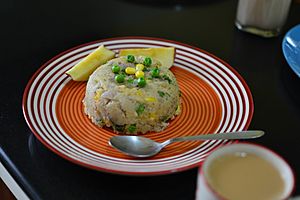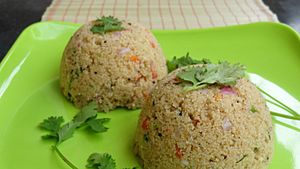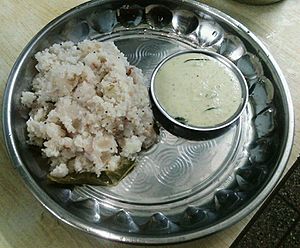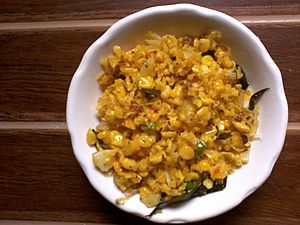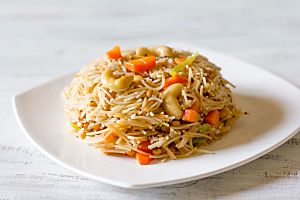Upma facts for kids
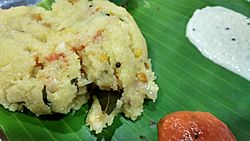
Upma
|
|
| Alternative names | Uppuma, Uppittu, Uppumavu, Uppindi, Kharabath, Upeet, Rulanv |
|---|---|
| Course | Breakfast |
| Place of origin | India |
| Main ingredients | Semolina or coarse rice flour |
Upma is a popular and tasty dish from the Indian subcontinent. It is often eaten for breakfast in many parts of India, like Kerala, Andhra Pradesh, Tamil Nadu, Telangana, Karnataka, and Maharashtra. People in Sri Lanka also enjoy it.
Upma is like a thick porridge. It is made from semolina or coarse rice flour that has been dry-roasted. Cooks often add different spices and vegetables. This makes each Upma dish special and unique.
Contents
What's in a Name?
The name "Upma" comes from old Indian languages. The word uppu means salt. The word mavu means ground grain meal. So, it's like "salty grain meal."
In different parts of India, Upma has other names. For example, in Maharashtra, it was traditionally called saanja. In Karnataka, it is often known as uppittu or kharabath.
| Nutritional value per 120 gm | |
|---|---|
| Energy | 1,046 kJ (250 kcal) |
|
45.67
|
|
| Dietary fiber | 3.2 g |
|
3.78
|
|
| Saturated | 0.916 g |
| Monounsaturated | 1.54 g |
| Polyunsaturated | 0.944 g |
|
Protein
|
8.11
|
| Minerals | Quantity
%DV†
|
| Potassium |
7%
223 mg |
| Sodium |
13%
190 mg |
|
Link to Fatsecret India
|
|
| †Percentages estimated using US recommendations for adults. | |
How to Make Upma
Making Upma is quite simple! First, you need semolina. This is also called rava or sooji in India. You lightly dry-roast the semolina in a pan. This step makes it taste better. Then, you set the roasted semolina aside.
Next, you heat some oil or ghee (a type of butter). You add spices, lentils, onions, and ginger. These ingredients are cooked until they are soft. After that, you add the roasted semolina back to the pan. You mix everything well.
Finally, you pour in boiling water. You stir the mixture until the semolina soaks up all the water. The Upma becomes soft and fluffy. You can add or remove spices and vegetables. This changes the taste and texture.
Different Kinds of Upma
There are many ways to make Upma. Each way offers a different taste.
Semolina Upma
This is the most common type of Upma. It uses semolina made from durum wheat. Sometimes, people add lots of vegetables. These can include beans, cashew nuts, and peanuts.
A special kind is masala upma. In Karnataka, it's called kharabath. This version uses sambar masala or garam masala. It also has red chilli powder instead of green chillies. This spicy Upma is very popular in South Indian restaurants. In Kerala, people often eat Uppumavu with mashed bananas for breakfast.
Whole Wheat Upma
This Upma is made with whole wheat or cracked wheat. It is popular in Tamil Nadu. People eat it for breakfast or dinner. Sometimes, vegetables like peas, carrots, and beans are added.
Upma Pesarattu
This is a very popular dish in Andhra Pradesh and Telangana. It combines Upma with another dish called Pesarattu. You eat the Upma by wrapping it inside the Pesarattu.
Rice Upma
Rice Upma is popular in Tamil Nadu and southern Karnataka. It is called akki tari uppittu. Sometimes, grated coconut is used instead of onions. This is common on holy days when onions are avoided. This Upma is often topped with ghee at the end. You can also make Upma from leftover bread crumbs or idli pieces.
Corn Upma
Corn Upma is another tasty variation. It is often eaten for breakfast. People sometimes add milk and nuts to it.
Kesari Bhath
In Karnataka, Upma is sometimes served with a sweet dish called kesari bhath. Both are placed on one plate. This combination is known as "chow chow bath."
Aval Upma or Atukula Upma
In Kerala and Andhra Pradesh, Upma can be made with flattened rice. This is instead of semolina. In Malayalam, it's called Aval Upmavu. In Telugu, it's called Atukulu Upma.
Vermicelli Upma
This is a light snack. It is made with vermicelli noodles. Tomatoes, peas, and carrots are often added. It's a great evening treat.
Upma with Ghugni
In Odisha, Upma is often eaten for breakfast with ghugni. Ghugni is a curry made from chickpeas or other legumes.


